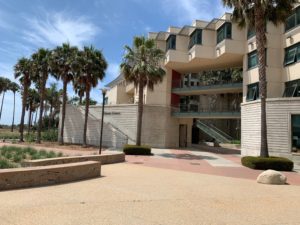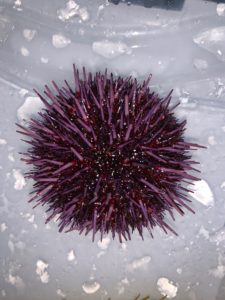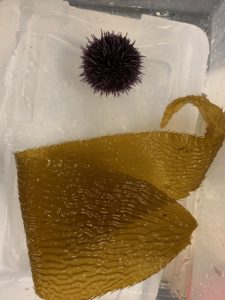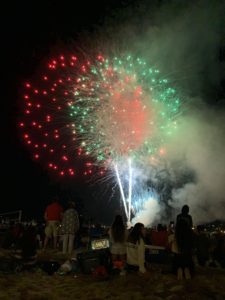Good day fellow Pinheads! My name is Jonah Jodlowski and I am a rising senior attending Telluride High School. This week was my first week working in the Marine Science Research Building (MSRB) located on the UCSB campus in beautiful Santa Barbara, California. Before any of you worry, I was unharmed by both the 6.4 degree earthquake and the 7.1 degree earthquake that shook most of the state. Where I was, they were barely noticed.
To start off my Pinternship™, I met with my mentor, Katrina Malakhoff, and all of the other interns that work with her. There are three total, including myself. I was informed of a lab that was starting temporarily. We would be feeding sea urchins – Mesocentrotus franciscanus (Red Sea urchins) and Strongylocentrotus purpuratus (Purple sea urchins) – different types of algae over a 2 week period to experimentally determine which type of algae provides the best nourishment for each species of sea urchin. For the experiment, Katrina hand caught each sea urchin from the Santa Barbara Channel Ecological Preserve. This preserve is a large body of water between Santa Barbara and the Channel Islands and is home to an abundance of MPAs or Marine Protected Areas. In these areas, it is illegal to fish for the protected sea urchin allowing them to thrive in bunches.
Our first task that needed to be completed before we started the experiment, was to find something for the Sea Urchins to starve in. We are required to starve the urchins for a week prior to their feeding period so that they have absolutely nothing in their systems before feeding begins. The starving containers had to allow water free-flow in and out of the containers while blocking solids from doing the same. We had no luck in doing this so we had to buy a bunch of small Tupperware™ items and drill holes in them. We also had to duct tape a mesh lining to every hole so that poop cannot travel through it during the experiment. The carbon-nitrogen content of the urchin feces will help us determine the health of each urchin.
This next week we will start the feeding period for the two species of urchins. The six species of algae that we will be working with are Macrocystis (Giant Kelp), Rhodymenia californica, Chondracanthus corymbiferus, Laminaria farlowii, and Pterygophora californica. Each urchin is around the same size and will be fed strictly one species of algae. The urchins will be evaluated preceding and succeeding the feeding period. Measuring algal consumption, test growth, jaw growth, change in whole body wet weight and gonad weight will help us determine which type of algae provides the superior nourishment for red and purple sea urchins.
When I was not working in the lab this week I was out and about exploring Santa Barbara and its world-famous beaches. For the Fourth, my housemate Bryce and I traveled to Stearns Wharf in downtown Santa Barbara to join the beachy extravaganza. Hundreds of people united on the sand in celebration. There was lots of beer chugging, diving for spikeballs, and large sand sculpture making. ‘Twas a time. We also went out on the harbor where we watched hundreds of multi-million dollar yachts come in for the infamous Independence Day fireworks. Once night broke, the fireworks wrapped up the week in incredible fashion and as Katy Perry once said, we “owned the night like the Fourth of July.”





There are no comments published yet.